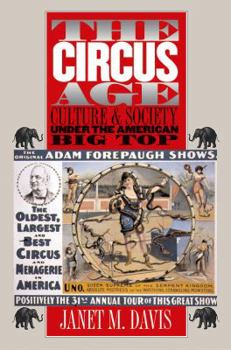The Circus Age: Culture and Society under the American Big Top
Select Format
Select Condition 
Book Overview
A century ago, daily life ground to a halt when the circus rolled into town. Across America, banks closed, schools canceled classes, farmers left their fields, and factories shut down so that everyone could go to the show. In this entertaining and provocative book, Janet Davis links the flowering of the early-twentieth-century American railroad circus to such broader historical developments as the rise of big business, the breakdown of separate spheres for men and women, and the genesis of the United States' overseas empire. In the process, she casts the circus as a powerful force in consolidating the nation's identity as a modern industrial society and world power. Davis explores the multiple "shows" that took place under the big top, from scripted performances to exhibitions of laborers assembling and tearing down tents to impromptu spectacles of audiences brawling, acrobats falling, and animals rampaging. Turning Victorian notions of gender, race, and nationhood topsy-turvy, the circus brought its vision of a rapidly changing world to spectators--rural as well as urban--across the nation. Even today, Davis contends, the influence of the circus continues to resonate in popular representations of gender, race, and the wider world.
Format:Hardcover
Language:English
ISBN:080782724X
ISBN13:9780807827246
Release Date:September 2002
Publisher:University of North Carolina Press
Length:360 Pages
Weight:1.22 lbs.
Dimensions:1.1" x 6.1" x 9.3"
Customer Reviews
4 ratings
Well-researched and highly informative
Published by Thriftbooks.com User , 15 years ago
Janet Davis' The Circus Age: Culture & Society Under The American Big Top is a very valuable book for anyone wanting to learn about the history of the American circus and the role it played in culture and society during the classic circus age back when the big circuses traversed the country by railroad and performed under canvas. Davis has done a remarkable amount of research, including finding and interviewing people whose tales about the circus give the reader real insight into what circus life was like and what the circus meant to people back when "Circus Day" was often the biggest event of the year. The book is fairly well illustrated with photographs of circus life and with the posters used to promote the various acts and spectacles the circus would bring to town. Among the wealth of information about the circus are the author's accounts of how extremely organized circuses were, particularly in the setting up and tearing down of the circus 'city' when it came and left town, a necessity born of using the tightly scheduled trains to travel the country. The following is a good example of the useful details Davis brings out in her book: "The 'army' of canvasmen who erected and tore down the billowing canvas tents was a crucial part of the total labor show. Audience members traveled in horse-drawn wagons over miles of bumpy dirt road in predawn darkness just to observe how circus workers (aided by horses and elephants) created a magical, moveable city on an empty lot. At the turn of the century... human and animal labor still performed virtually all the on-site jobs, before gasoline-engine stake-drivers and other motorized machines began replacing some of the human labor in 1910-1920. The creation of the tented city was a thrilling physical feat in which human labor functioned as a seemingly seamless, corporate body." --"Immediately after the circus trains arrived at the show grounds, the boss canvasman, who directed the erection of the tents, scouted out the lot, which occupied ten acres or so. He first decided where the big top should stand, which determined the position of the other eleven tents. A group of canvasmen used iron rods to mark the positions of the five center poles, which would be the tent's center of gravity, and then mapped the perimeter of Barnum & Bailey's 1894 big top - 440 feet by 180 feet - with more rods, topped with little flags, color-coded red or blue to identify each tent site. Next, the boss canvasman and his crew marked the placement of the menagerie tent, which was connected to the big top by a neck of canvas. The perimeter of the menagerie - 360 feet by 160 feet - was identified by rods topped by white flags. This process was completed in just eight minutes from start to finish. The crew then quickly mapped out the placement of the dressing-room tent, two horse tents, the wardrobe tents, the sideshow tent, the freaks' dressing-room tent, and several smaller tents for the blacksmith shop, the repair shop, an
Just What I was Looking For
Published by Thriftbooks.com User , 16 years ago
After a surprisingly interesting visit to the Ringling Museum in Sarasota I was anxious to know more about this unsung chapter of American History. This book was everything I wanted and more. Full of well researched facts, insightful conclusions and fascinating details, it reads like a dream. If I could give it 6 stars I would! Well done Janet M. Davis.
Great!
Published by Thriftbooks.com User , 18 years ago
after reading "WATER FOR ELEPHANTS" I needed some circus history and this book was great. Love the pictures. This was a pleasure to read.
Fine Historical Work on the American Circus
Published by Thriftbooks.com User , 20 years ago
Davis' book is a rare scholarly exploration of the history of the American circus. She makes smart conclusions about this Amercan instituion. Her work is well documented and a pleasure to read.





